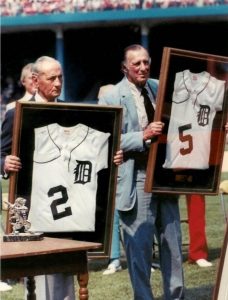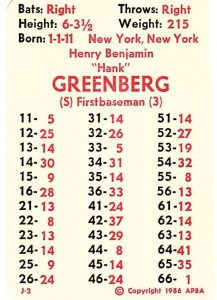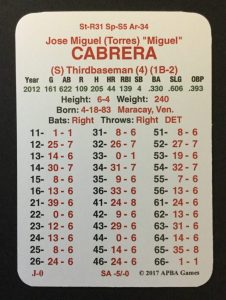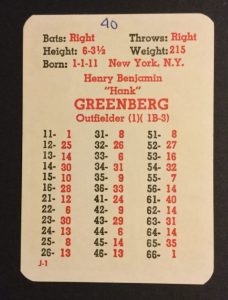I was privileged to see Hank Greenberg’s final appearance at Tiger Stadium in Detroit. It was June 12, 1983 and the Tigers were retiring Hank Greenberg’s number 5 jersey and Charlie Gerhringer’s number 2 jersey.  The ceremony was held at midfield between games of a doubleheader between the Tigers and Cleveland Indians. Over 34,000 fans were in attendance to watch the teams split the doubleheader. Amazingly, the first game only took two hours and thirty-nine minutes, and the second game was an even faster two hours and ten minutes. I’m sure many MLB fans would appreciate those game times in 2018. Three future Hall of Famers played in the doubleheader: Bert Blyleven, Alan Trammell, and Jack Morris.
The ceremony was held at midfield between games of a doubleheader between the Tigers and Cleveland Indians. Over 34,000 fans were in attendance to watch the teams split the doubleheader. Amazingly, the first game only took two hours and thirty-nine minutes, and the second game was an even faster two hours and ten minutes. I’m sure many MLB fans would appreciate those game times in 2018. Three future Hall of Famers played in the doubleheader: Bert Blyleven, Alan Trammell, and Jack Morris.
Rightly so, much has been made of the seasons lost to military service of players like Ted Williams, Joe DiMaggio, and Stan Musial. However, it should be remembered that Hank Greenberg lost nearly four and a half years to World War II. If he could have played the seasons of his early 30s, it’s highly likely he would have been just the fourth player in history to reach 500 home runs. Coupled with his .313 career batting average, his mark as one of the greatest right handed hitters would be obvious to all baseball historians. Greenberg’s career statistics would have been very similar to Jimmie Foxx’s. Yet, Hank thought it was more important to fight Nazis than play baseball. I can’t say I disagree with him.
| I | Split | G | GS | PA | AB | R | H | 2B | 3B | HR | RBI | SB | CS | BB | SO | BA | OBP | SLG | OPS | GDP | IBB |
|---|---|---|---|---|---|---|---|---|---|---|---|---|---|---|---|---|---|---|---|---|---|
| 1947 Totals | 125 | 118 | 510 | 402 | 71 | 100 | 13 | 2 | 25 | 74 | 0 | 4 | 104 | 74 | .249 | .408 | .478 | .885 | 16 | 8 |
Hank Greenberg’s final APBA card is solid. It has excellent power numbers with an 11-5, 33-5, and 66-1. It also should produce an excellent on base percentage with seven 14s. That’s because Greenberg led the National League with 104 base on balls in 1947, which helped him produce a .408 OBP. My calculations have this card at a .241 average, which is pretty close to the .249 average Hank hit for during the season. On the negative side, Hank hit into 16 double plays, which earned him three 24s on this APBA card.
Greenberg’s final season in Pittsburgh was productive in other ways. First, Hank became a huge influence on future Hall of Famer Ralph Kiner. In 1946, before Greenberg arrived, Kiner was a raw, free-swinging slugger. He stuck out a league-leading 109 times. In spring training 1947, Greenberg took the budding star under his wing. He taught him how to study pitchers and become more disciplined at the plate. Kiner career took off in 1947, and hit .313 with 51 homers and 127 RBI. In his career, he would never again strike out a 100 times in a season. Kiner has said nobody had a bigger influence on his career than Hank Greenberg. Second, Greenberg was influential in helping Jackie Robinson deal with the racism and bigotry he experienced during his rookie season. Hank had a unique perspective on intolerance as he constantly had to deal with anti-semitism during his career.
In Detroit, Hank Greenberg still holds a special place in the hearts of Tigers fans. As of now (with Trammell and Morris coming this summer), only six numbers have been retired in Detroit Tigers history. Greenberg’s number retirement is as deserving as anyone’s. He is the only Tiger to play on four World Series teams, and he is the only two-time World Series champion in club history (1935 & 1945). Playing in an era before television, it’s hard to picture the kind of player Greenberg was. The closest we’ve seen in Detroit is Miguel Cabrera in his prime. Greenberg and Cabrera are more statistically similar than you might think. Cabrera is a career .316 hitter with a .946 OPS. Greenberg was a career .313 hitter with a 1.017 OPS.
Let’s take a look at two typical seasons from Greenberg’s and Cabrera’s primes:1940 for Hammerin’ Hank & 2012 for Miggy, when he won the Triple Crown. Cabrera hit .330 with 44 homers and 139 RBI. Greenberg hit .340 with 41 homers and 150 RBI. Greenberg gets the edge for these cards, but they are remarkably similar. However, I would have loved to see Cabrera hit at Tiger Stadium. With the short overhang in right field (where he hits a lot of baseballs) to the short power alleys, I think Miggy would have hit .340+ with 50 homers and 150 RBI in 2012.
This leads us to to one of the many beautiful things about baseball. It’s still game in which we can compare modern players with those from more than 70 years ago. Could Miguel Cabrera have been a star in 1940? Would Hank Greenberg have produced similar numbers in 2012? I think so. In the end, baseball is still baseball. It’s also why APBA was great in our childhoods, and it’s still great as we age.








I read where Greenberg said he was “playing from memory” after he came back from military service. Awfully good, if he was.
Kevin,
Another great post !! Your stories about the Tiger greats are always exciting and enjoyable to read. I was interested how Steve’s APBA Card Computer would create the same 1947 card…what a remarkable similarity.
Great article – keep up the excellent work!